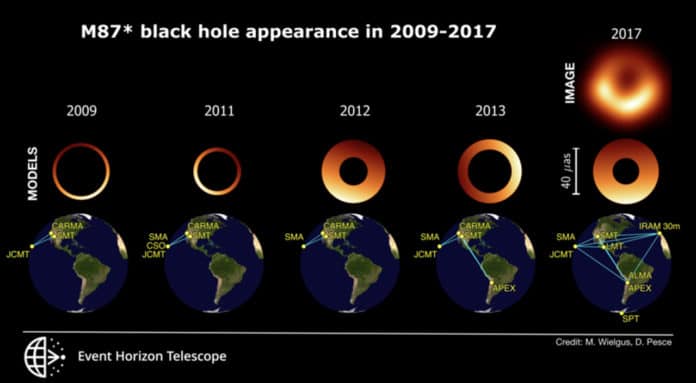In April 2019, scientists obtained the first image of a black hole M87, using Event Horizon Telescope observations of the center of the galaxy M87.
The EHT team has used the lessons learned last year to analyze the archival data sets from 2009 to 2013. Their analysis reveals the black hole image’s behavior across multiple years, indicating the persistence of the crescent-like shadow feature. Still, also a variation of its orientation — the crescent appears to be wobbling.
The 2009–2013 observations comprise less information than those performed in 2017, making it challenging to create an image. Be that as it may, the EHT group had the option to use statistical modeling to take a gander at changes in the appearance of M87* after some time. In the modeling approach, the data are compared to a group of geometric templates, for this situation, rings of non-uniform brightness. A statistical framework is then used to decide whether the data are reliable with such models and locate the best-fitting model parameters.
Colin Lonsdale, director of MIT Haystack Observatory and chair of the EHT Collaboration Board, said, “This is a beautiful example of creative data analysis. Extracting important new astrophysical understanding and squeezing new insight into previous observations is an imaginative example of how scientists can maximally use the information content of such painstakingly collected data. The behavior of this event horizon scale structure over the years allows important additional constraints to be placed on the properties of this fascinating object.”
This study has shown that M87* adheres to theoretical expectations. The black hole’s shadow diameter has remained consistent with the prediction of Einstein’s theory of general relativity for a black hole of 6.5 billion solar masses.
Kazu Akiyama, a research scientist at MIT Haystack Observatory, said, “In this study, we show that the general morphology, or presence of an asymmetric ring, most likely persists on timescales of several years. The consistency throughout multiple observational epochs gives us more confidence than ever about the nature of M87* and the origin of the shadow.”
Scientists found that the ring is wobbling, and that means big news for scientists. For the first time, they can get a glimpse of the accretion flow’s dynamical structure so close to the black hole’s event horizon, in extreme gravity conditions.
Studying this region holds the key to understanding phenomena such as relativistic jet launching, and will allow scientists to formulate new tests of the theory of general relativity.
Maciek Wielgus of the Harvard and Smithsonian Center for Astrophysics said, “The gas falling onto a black hole heats up to billions of degrees, ionizes, and becomes turbulent in the presence of magnetic fields. Because the flow of matter is turbulent, the crescent appears to wobble with time.”
“We see quite a lot of variation there, and not all theoretical models of accretion allow for so much wobbling. What it means is that we can start ruling out some of the models based on the observed source dynamics.”
Vincent Fish, a research scientist at Haystack Observatory, said, “MIT Haystack Observatory was instrumental in organizing these early observations, correlating the massive amounts of data returned on large numbers of hard drives, and reducing the data. While we were able to place important constraints on the size and nature of the emission in M87* at the time, the images made from the much better 2017 array data provided critical context for fully understanding what the earlier data were trying to tell us.”
Journal Reference:
- Maciek Wielgus et al. Monitoring the Morphology of M87* in 2009–2017 with the Event Horizon Telescope. DOI: 10.3847/1538-4357/abac0d
